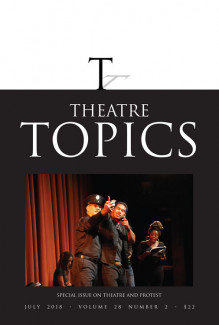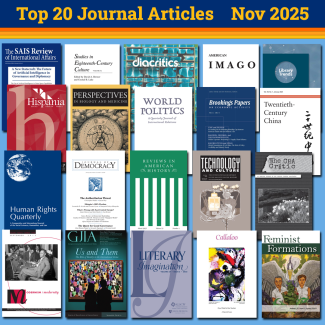
Johns Hopkins UniversityEst. 1876
America’s First Research University
Responding Through Art

Earlier this year, Theatre Topics published a special issue on "Theatre and Protest." The issue featured eight essays as well as production notes from a half-dozen campus performances of either "Every 28 Hours" or "After Orlando," short-form dramas designed to react quickly to current events. Journal editor Lisa Brenner joined us for a discussion about releasing this issue during the current climate of protest and action.

Did you have any challenges in putting this issue together?
The biggest challenge in putting this issue together was coordinating all the moving parts. I wanted the issue to be inclusive of many topics surrounding protest: the environment, women’s rights, racial violence, etc. So, that meant there were several pieces. In one section, we included various takes on the same two projects: “Every 28 Hours” and “After Orlando” respectively.
How important is it for an editor to take her personal experience and use that to mold an issue, like you describe in your introduction?
I struggled with this question. On the one hand, I didn’t think it was appropriate to talk about myself—I’m the editor, not an author. On the other hand, I felt it was important for readers to know why I had chosen this theme, and how my thoughts on this topic shifted as I was working on this issue. With Theatre Topics, we publish one special issue every year. I take great pains in choosing the theme for the special issue. It’s a unique opportunity to create discourse around something I feel passionate about—as well as keeping my eyes and ears open to what topics seem to be important to others in the field. When I joined the editorial team three years ago, I hadn’t anticipated that I would do a special issue on protest. But I think my job as theatre scholar and practitioner is to respond to the world around me through my art. After the 2016 US presidential election, therefore, this theme was really on my mind. In addition, it occurred to me that this issue would mark fifty years since 1968, a time many associate with protest. I wondered how artists, scholars, and teachers were responding to this moment as had their predecessors.
What impact does the new online section of the journal have on putting an issue like this together?
The new online section does two important things. The first is it allows us to take advantage of the visual medium. Pieces like Susanne Shawyer’s “Rural Theatrical Protest: A Note from Muskrat Falls” and “Mining the Past to Inform the Present: Two Artists Discuss Performance as Protest” by Kimani Fowlin and Megan J. Minturn benefit from the inclusion of color images that illustrate the text. In the special issue I edited on Devised Performance, we were able to embed videos from Tectonic Theater as part of an interview with the company. These additions give the reader a more in depth look at the work. Second, the online section provides opportunities for greater access and visibility. In conjunction with the special issue on Theatre and Protest, we were fortunate to include a never before published interview with Judith Malina. Considering Malina’s stature, we felt that this interview would be of interest to many scholars and practitioners. In our first issue of 2019, we are publishing a key note address by Quiara Alegría Hudes and her sister Gabriella Sanchez. The online section will include responses to the address from leaders in the field. In this sense, it becomes a platform for continuing dialogue.
How do you hope this issue is used in the field?
In terms of the special issue on Theatre and Protest, I hope that professors assign articles from it to their students. I have used several articles from Theatre Topics in my classes, and it’s great for students to get a sense of what is happening in the field, as well as to reflect on the various arguments. I hope that scholars find materials that adds to their research and that these essays and interviews enrich the discourse on how art both responds to social/cultural/political events as well as shapes them, and I hope that artists find inspiration in the work of their contemporaries. I also appreciate that the materials discuss the challenges and limitations associated with this work. Some readers will disagree with points made or have different experiences depending on their location—as in their personal positions as well as the geographic place that they live/work. However, I hope that this journal provides a space for conversation and exchange. It’s especially exciting to me that Theatre Topics has become more international in the last few years. I hope this issue provides connections—and who knows, maybe even future collaborations.


